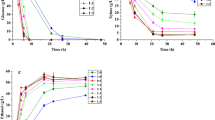Abstract
In the production of ethanol from lignocellulosic biomass, the hydrolysis of the acetylated pentosans in hemicellulose during pretreatment produces acetic acid in the prehydrolysate. The National Renewable Energy Laboratory (NREL) is currently investigating a simultaneous saccharification and cofermentation (SSCF) process that uses a proprietary metabolically engineered strain ofZymomonas mobilis that can coferment glucose and xylose. Acetic acid toxicity represents a major limitation to bioconversion, and cost-effective means of reducing the inhibitory effects of acetic acid represent an opportunity for significant increased productivity and reduced cost of producing fermentation fuel ethanol from biomass. In this study, the fermentation performance of recombinant Z.mobilis 39676:pZB4L, using a synthetic hardwood prehydrolysate containing 1% (w/v) yeast extract, 0.2% KH2PO4, 4% (w/v) xylose, and 0.8% (w/v) glucose, with varying amounts of acetic acid was examine. To minimize the concentration of the inhibitory undissociated form of acetic acid, the pH was controlled at 6.0. The final cell mass concentration decreased linearly with increasing level of acetic acid over the range 0-0.75% (w/v), with a 50% reduction at about 0.5% (w/v) acetic acid. The conversion efficiency was relatively unaffected, decreasing from 98 to 92%. In the absence of acetic acid, batch fermentations were complete at 24 h. In a batch fermentation with 0.75% (w/v) acetic acid, about two-thirds of the xylose was not metabolized after 48 h. In batch fermentations with 0.75% (w/v) acetic acid, increasing the initial glucose concentration did not have an enhancing effect on the rate of xylose fermentation. However, nearly complete xylose fermentation was achieved in 48 h when the bioreactor was fed glucose. In the fed-batch system, the rate of glucose feeding (0.5 g/h) was designed to simulate the rate of cellulolytic digestion that had been observed in a modeled SSCF process with recombinant Zymomonas. In the absence of acetic acid, this rate of glucose feeding did not inhibit xylose utilization. It is concluded that the inhibitory effect of acetic acid on xylose utilization in the SSCF biomass-to-ethanol process will be partially ameliorated because of the simultaneous saccharification of the cellulose.
Similar content being viewed by others
References
Zhang, M., Franden, M. A., Newman, M., McMillan, J., Finkelstein, M., and Picataggio, S. (1995),Appl. Biochem. Biotechnol. 51/52, 527–536.
Picataggio, S. K., Zhang, M., and Finkelstein, M. (1994), inEnzymatic Conversion of Biomass for Fuels Production, Himmel, M. E., Baker, J. O., and Overend, R. A., eds., American Chemical Society, Washington, DC,ACS Symposium Series 566, pp. 342–362.
Zhang, M., Eddy, C., Deanda, K., Finkelstein, M., and Picataggio, S. K. (1995),Science,267, 240–243.
Picataggio, S. K., Zhang, M., Eddy, C. K, Deanda, K. A., and Finkelstein, M. (1996), US Patent 5,514,583.
Wright, J. D. (1988),Chem. Eng. Prog. 84, 62–74.
Grethlein, H. E. (1985),BioTechnology 3, 155–160.
Grethlein, H. E., Allen, D. C., and Converse, A. O. (1984),Biotech. Bioeng. 26, 1498–1505.
Torget, R., Werdene, P., Himmel, M., and Grohmann, K. (1990),Appl. Biochem. Biotechnol. 24/25, 115–126.
Grohmann, K., Himmel, M., Rivard, C., Tucker, M., Baker, T. Torget, R., and Graboski, M. (1984),Biotechnol. Bioeng. Symp. 14, 139–157.
Kong, F., Engler, C. R., and Soltes, E. (1992),Appl Biochem. Biotechnol. 34/35, 23–35.
Timell, T. E. (1964),Adv. Carbohydr. Chem. 19, 247–302.
Lawford, H. G. and Rousseau, J. D. (1993), inEnergy from Biomass and Wastes XVI. (1992) Klass, D. L., ed., Institute of Gas Technology, Chicago, pp. 559–597.
Lawford, H. G. and Rousseau, J. D. (1993),Appl. Biochem. Biotechnol. 39/40, 667–685.
McMillan, J. D. (1994), inEnzymatic Conversion of Biomass for Fuels Production, Himmel, M. E., Baker, J. O., and Overend, R. A., eds., American Chemical Society, Washington, DC,ACS Symposium Series 566, pp. 411–437.
Freese, E., Sheu, C. W., and Galliers, E. (1973),Nature 241, 321–326.
Booth, I. R. (1985),Microbiol. Rev. 49, 63–91.
Prior, B. A., Killan, S. G., and Du Preez, J. C. (1989),Process Biochem. 24, 21–32.
Lawford, H. G. and Rousseau, J. D. (1993),Appl. Biochem. Biotechnol. 39/40, 301–322.
Lawford, H. G. and Rousseau, J. D. (1994),Appl. Biochem. Biotechnol. 45/46, 437–448.
Lawford, H. G. and Rousseau, J. D. (1991),Biotechnol. Letts. 13, 191–196.
Lawford, H. G. and Rousseau, J. D. (1993), in:Energy from Biomass and Wastes XVI, Klass, D. L., ed., Institute of Gas Technology, Chicago, IL, pp. 559–597.
Lawford, H. G. and Rousseau, J. D. (1992),Appl. Biochem. Biotechnol. 34/35, 185–204.
Lawford, H. G. and Rousseau, J. D. (1993),Appl. Biochem. Biotechnol. 39/40, 687–699.
Lawford, H. G., Rousseau, J. D., and McMillan, J. D. (1997),Appl. Biochem. Biotechnol. 63-65, 269–286.
Hinman, N. D., Wright, J. D., Hoagland, W., and Wyman, C. E. (1989),Appl. Biochem. Biotechnol. 20/21, 391–401.
Hinman, N. D., Schell, D. J., Riley, C. J., Bergeron, P. W., and Walter, P. J. (1992),Appl. Biochem. Biotechnol. 34/35, 639–649.
Lynd, L. R. (1990),Appl. Biochem. Biotechnol. 24/25, 695–719.
Picataggio, S. K., Eddy, C, Deanda, K., Franden, M. A., Finkelstein, M., and Zhang, M. (1996),Seventeenth Symposium on Biotechnology for Fuels & Chemicals (Paper #9).
Lawford, H. G., Rousseau, J. D., Mohagheghi, A., and McMillan, J. D. (1998),Appl. Biochem. Biotechnol, (19th Symp) 70–72.
Goodman, A. E., Rogers, P. L., and Skotnicki, M. L. (1982),Appl. Environ. Microbiol. 44, 496–498.
Lawford, H. G. and Ruggiero, A. (1990),Biotechnol. Appl. Biochem. 12, 206–211.
Lawford, H. G., Holloway, P., and Ruggiero, A. (1988),Biotechnol. Letts. 10, 809–814.
DiMarco, A. and Romano, A. H. (1985),Appl. Environ. Microbiol. 49, 151–157.
Author information
Authors and Affiliations
Rights and permissions
About this article
Cite this article
Lawford, H.G., Rousseau, J.D. Improving fermentation performance of recombinant zymomonas in acetic acid-containing media. Appl Biochem Biotechnol 70, 161–172 (1998). https://doi.org/10.1007/BF02920133
Issue Date:
DOI: https://doi.org/10.1007/BF02920133




